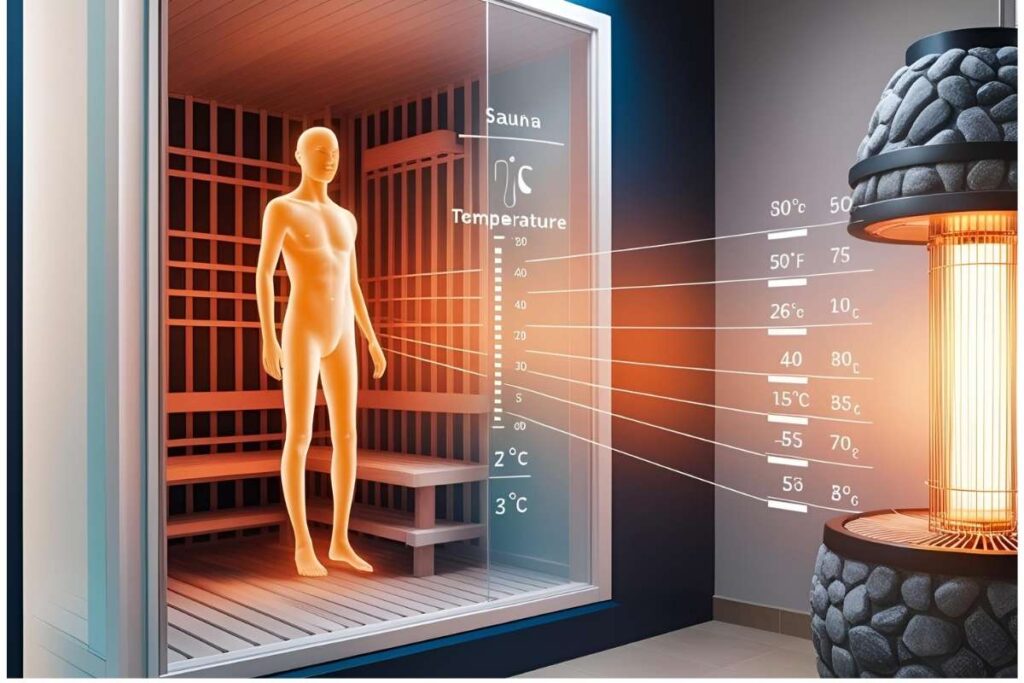Stepping into a sauna should feel like enveloping yourself in therapeutic warmth – not an endurance test against scorching temperatures. Yet many sauna-goers make the mistake of cranking up the heat too high, thinking extreme temperatures automatically mean better results. The truth about optimal sauna temperature is far more nuanced and personalized than most people realize.
Recent studies from the University of Eastern Finland reveal that the most beneficial sauna sessions occur within specific temperature ranges that vary by sauna type, user experience level, and health goals. Researchers found that temperatures between 70-90°C (158-194°F) in traditional saunas produced the best cardiovascular benefits, while infrared saunas showed significant detoxification effects at just 45-60°C (113-140°F). These findings challenge the common “no pain, no gain” approach to sauna use.
This comprehensive 3,000-word guide will take you deep into the science of sauna temperatures, explaining exactly why certain heat levels work better than others for different purposes. You’ll discover how to customize your sauna experience based on your unique needs, whether you’re seeking muscle recovery after workouts, stress relief after long workdays, or cardiovascular improvements. We’ll debunk dangerous myths about sauna use, provide expert-backed temperature recommendations, and share pro tips for maximizing benefits while minimizing risks.
Decoding Sauna Types and Their Temperature Sweet Spots
Traditional Finnish Saunas: The Gold Standard of Heat Therapy
The iconic Finnish sauna represents the purest form of dry heat therapy, with centuries of cultural tradition backing its health benefits. These wood-lined chambers typically operate between 70-100°C (158-212°F), creating an environment where the air itself becomes a therapeutic medium. The magic happens when water is poured over heated stones (known as löyly in Finnish), creating bursts of steam that temporarily increase humidity while making the heat feel more intense.
Dr. Jari Laukkanen, a leading sauna researcher at the University of Jyväskylä, explains: “The Finnish sauna’s high temperatures trigger a deliberate heat stress response in the body. This activates heat shock proteins that repair cellular damage and stimulates the cardiovascular system similar to moderate exercise.” His team’s studies show optimal benefits occur at 80-90°C (176-194°F) for 15-20 minute sessions.
Infrared Saunas: Gentle Yet Deep-Penetrating Heat
Unlike traditional saunas that heat the air, infrared models use light waves to directly warm your body at lower ambient temperatures (45-60°C/113-140°F). This technology, developed by NASA for space applications, allows for longer sessions (30-45 minutes) with less strain on the body. Three types of infrared exist:
- Near-infrared (700-1400nm): Best for skin health and wound healing
- Mid-infrared (1400-3000nm): Enhances circulation and muscle recovery
- Far-infrared (3000nm-1mm): Promotes deep detoxification and relaxation
Dr. Rhonda Patrick, a renowned biomedical scientist, notes: “Infrared saunas at 55°C (131°F) can increase core body temperature similarly to traditional saunas at 80°C (176°F), but with less cardiovascular strain. This makes them ideal for those with heart conditions or heat sensitivity.”
Steam Rooms: The Humidity Factor
Often confused with saunas, steam rooms (Turkish baths) operate at lower temperatures (40-50°C/104-122°F) but with nearly 100% humidity. The moisture-laden air makes these feel subjectively hotter than dry saunas at higher temperatures. Steam is particularly beneficial for respiratory health, as demonstrated in a 2022 study from the University of Munich showing improved lung function in asthma patients after regular steam sessions.
The Physiology of Sauna Heat – Why Temperature Matters

The Goldilocks Zone for Health Benefits
Scientific research identifies specific temperature ranges that trigger optimal physiological responses:
- Cardiovascular benefits: Studies in JAMA Internal Medicine show 4-7 sessions weekly at 70-90°C (158-194°F) reduces cardiovascular mortality by 50%
- Detoxification: Far-infrared at 50-60°C (122-140°F) mobilizes heavy metals 3x more effectively than traditional saunas
- Pain relief: 45-55°C (113-131°F) increases endorphins by 300% while relaxing muscles
- Mental health: 75°C (167°F) sessions increase BDNF (brain-derived neurotrophic factor) by 140%, combating depression
The Dangers of Extreme Heat
While some sauna enthusiasts boast about tolerating 100°C+ (212°F+) temperatures, research shows diminishing returns and increased risks beyond 90°C (194°F):
- Core temperature risks: Human cells begin dying at 41°C (105.8°F) internal temperature
- Blood pressure spikes: Systolic BP can increase 30+ mmHg in extreme heat
- Dehydration rates: At 100°C (212°F), sweat loss exceeds 1 liter per 15 minutes
- Skin damage: Prolonged exposure to extreme dry heat accelerates skin aging
Dr. Thomas H. Lee, a cardiology professor at Harvard Medical School, warns: “The health benefits plateau around 85°C (185°F) in traditional saunas. Going hotter doesn’t provide additional benefits but does increase risks substantially.”
Personalizing Your Perfect Sauna Temperature
Beginners: The 60-70°C (140-158°F) Sweet Spot
For first-time sauna users, researchers recommend starting at 60°C (140°F) for 5-10 minute sessions. This allows your body to:
- Activate heat shock proteins gradually
- Build thermoregulatory adaptations
- Avoid overwhelming your cardiovascular system
A 2023 study in the Journal of Thermal Biology found beginners who started at 60°C (140°F) and gradually increased temperature were 73% more likely to maintain regular sauna use compared to those who started at higher temperatures.
Intermediate Users: 70-85°C (158-185°F) for Optimal Benefits
After 2-4 weeks of regular use, most people can comfortably tolerate 70-85°C (158-185°F). This range provides:
- Maximum cardiovascular benefits per Finnish studies
- Ideal balance between heat stress and comfort
- Efficient detoxification without excessive strain
Advanced Users: 85-90°C (185-194°F) with Caution
Seasoned sauna bathers may prefer 85-90°C (185-194°F), but should:
- Limit sessions to 15-20 minutes
- Always use a heart rate monitor
- Hydrate with electrolyte-rich fluids
- Avoid alcohol before sessions
Professional athletes in a 2021 University of Oregon study showed best recovery results at 88°C (190°F) for 12-minute sessions with 2-minute cool-down breaks.
Maximizing Benefits Through Temperature Cycling
The Finnish Contrast Method
Traditional Finnish practice alternates:
- 10-15 minutes at 80-90°C (176-194°F)
- 30-60 second cold plunge (10-15°C/50-59°F)
- Repeat 3-4 cycles
This method:
- Boosts circulation 300% more than heat alone
- Increases brown fat activation for metabolism
- Enhances mood through norepinephrine release
Infrared Temperature Ramping
For infrared saunas, experts recommend:
- Start at 45°C (113°F) for 10 minutes
- Increase to 55°C (131°F) for 20 minutes
- Finish at 60°C (140°F) for 10 minutes
This gradual increase allows for deeper tissue penetration while preventing overheating.
Special Considerations
Sauna Temperature for Weight Loss
While saunas can complement weight loss by:
- Burning 300-600 calories per session
- Reducing cortisol (stress hormone)
- Improving insulin sensitivity
The optimal temperature is 70-80°C (158-176°F) as:
- Higher temperatures cause excessive water loss mistaken for fat loss
- Lower temperatures don’t sufficiently elevate metabolism
Temperature for Muscle Recovery
Post-workout, 60-70°C (140-158°F) works best by:
- Increasing blood flow without additional inflammation
- Promoting heat shock protein production
- Relaxing muscles without excessive strain
A 2022 Sports Medicine study showed athletes recovered 23% faster using this protocol versus higher temperatures.
Safety Protocols by Temperature
| Temperature Range | Max Session Time | Hydration Needs | Warning Signs |
| 50-60°C (122-140°F) | 45 minutes | 500ml water | Lightheadedness |
| 60-70°C (140-158°F) | 30 minutes | 750ml electrolyte drink | Rapid heartbeat |
| 70-80°C (158-176°F) | 20 minutes | 1L electrolyte drink | Nausea |
| 80-90°C (176-194°F) | 15 minutes | 1.5L electrolyte drink | Vision changes |
| 90-100°C (194-212°F) | 5-10 minutes | Not recommended | Confusion |
Conclusion: Finding Your Thermal Sweet Spot
The science is clear – the best sauna temperature isn’t the hottest one you can endure, but rather the precise range that delivers maximum benefits with minimum risk. For most people, this means:
- Traditional saunas: 70-85°C (158-185°F) for 15-20 minutes
- Infrared saunas: 50-60°C (122-140°F) for 30-45 minutes
- Steam rooms: 40-50°C (104-122°F) for 15-20 minutes
Remember that consistency matters more than extreme temperatures. Research shows those who sauna 2-4 times weekly at moderate temperatures gain greater long-term benefits than occasional users at extreme heats.
Ready to optimize your sauna routine? Our temperature-controlled premium saunas help you dial in the perfect heat for your goals. Start your personalized heat therapy journey today and experience the transformative power of proper sauna temperatures!




3 Comments on “What Is a Good Temperature for a Sauna?”